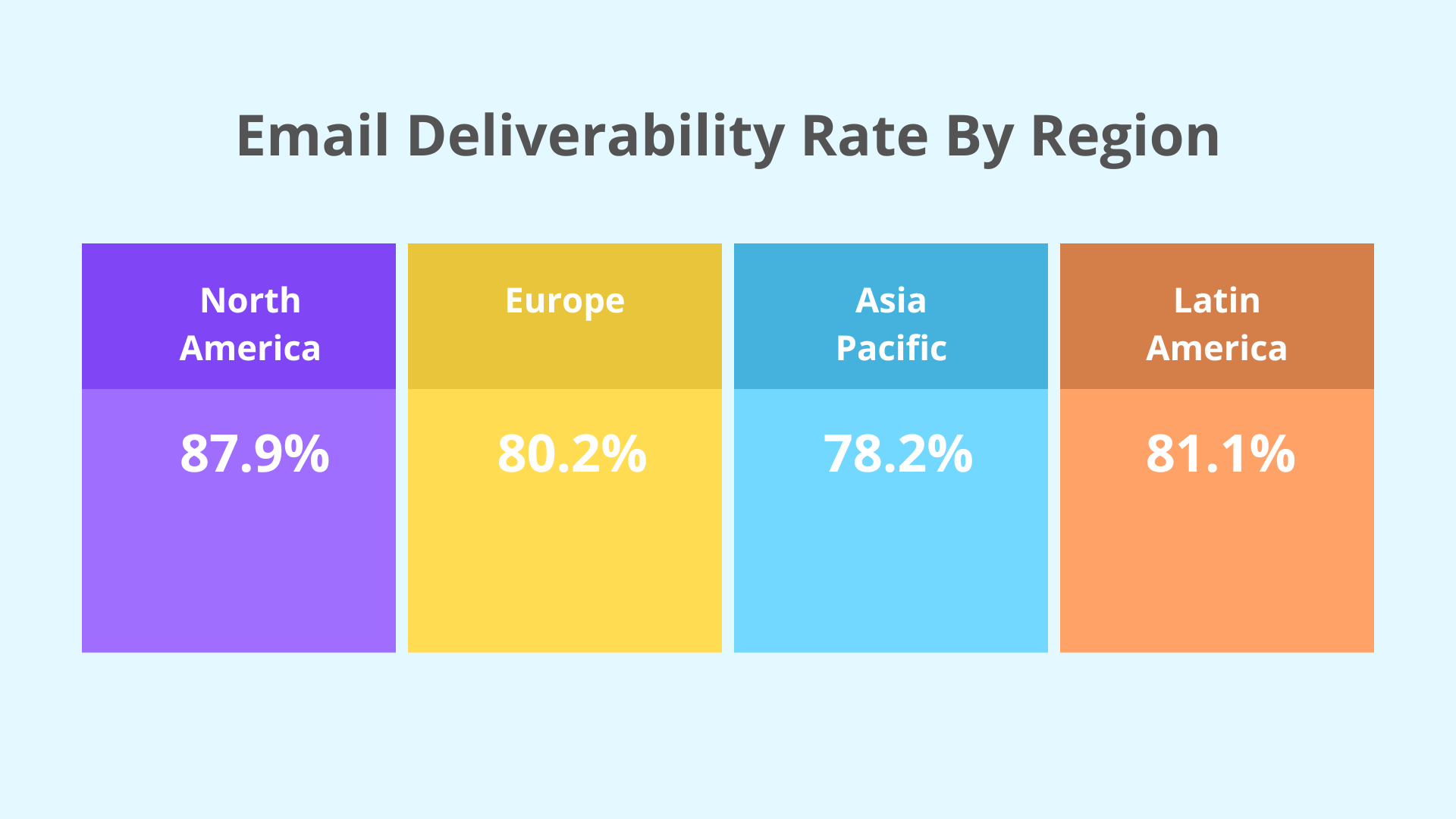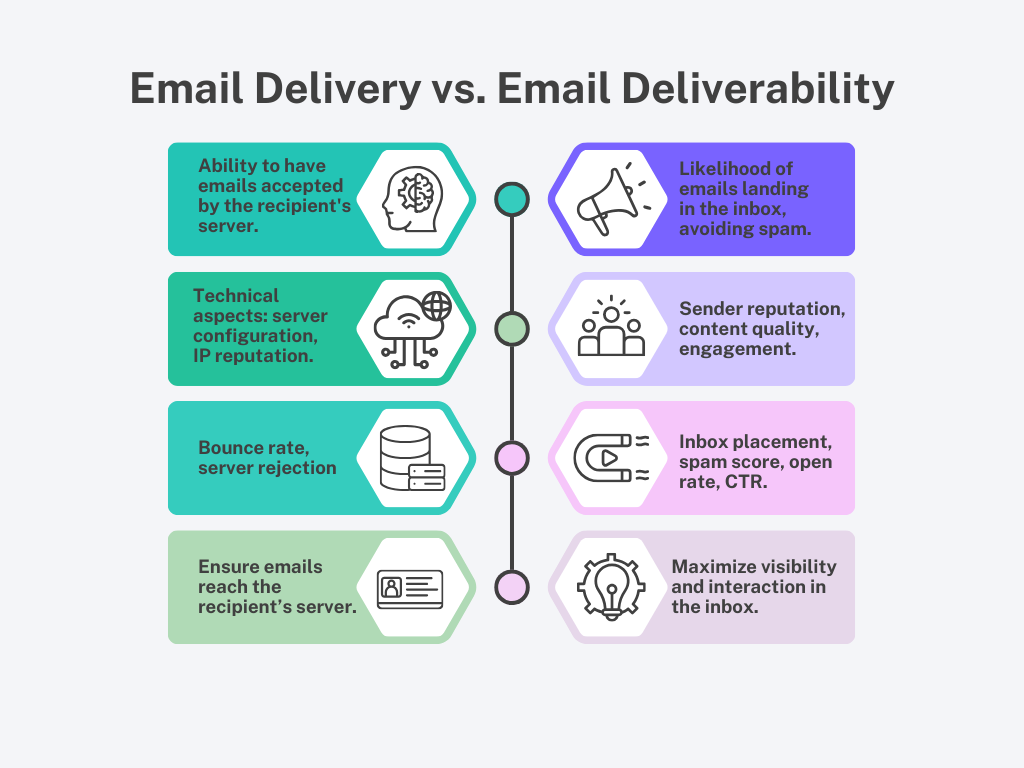Email deliverability refers to the ability of your emails to successfully land in your recipients’ inboxes rather than being filtered as spam or bouncing back. It’s not just about sending emails—it’s about ensuring they reach the intended audience in a way that drives engagement and avoids delivery obstacles.
This metric is a cornerstone of successful email marketing campaigns, as it directly impacts your ability to connect with your audience.
Effective email deliverability combines several factors, including maintaining a clean email list, following best practices for sender reputation, and crafting relevant, high-quality content that resonates with your audience.

Poor deliverability can render even the most compelling campaigns ineffective, as undelivered or unnoticed emails lead to lost opportunities and decreased ROI.
Ensuring optimal email deliverability is about more than just audience-building; it’s about fostering trust and consistency with your recipients, encouraging them to open and interact with your messages time after time.
📊 Monitor and Analyze Metrics: Regularly track key email deliverability metrics to identify trends and areas for improvement. Use this data to optimize your email campaigns for better performance.
— Email Industries (@emailindustries) August 14, 2024
Key improvements:
- Simplified and clarified the explanation of email deliverability.
- Incorporated language that aligns with the tone and detail level of your competitors.
- Added relevant concepts such as sender reputation and high-quality content, inspired by competitors’ insights.
- Removed repetitive phrases and improved the flow for readability.
How Email Deliverability Works
Email deliverability entails more than the straightforward initiation of an email; it involves a multifaceted set of factors and processes that determine whether your email reaches its intended destination or ends up in a spam folder or gets rejected altogether.
In essence, it’s about maximizing the chances that your email lands in the recipient’s inbox and gets noticed.

Email deliverability involves a series of steps and checks that happen behind the scenes. Here’s a simplified overview of how it works:
-
- Sender Initiates Email: It all starts when the sender, which could be an individual or an organization, composes an email and hits “send.”
- Email Service Provider (ESP) Receives Email: The email is transmitted to the sender’s ESP (e.g., Gmail, Outlook, or a marketing automation platform).
- ESP Evaluates Email: The ESP performs various checks on the email, including sender authentication, content analysis, and recipient engagement history. It assesses the sender reputation and the email’s compliance with anti-spam regulations.
- Email Sent to Recipient’s Server: If the ESP approves the email, it is sent to the recipient’s email server.
- Recipient’s Server Evaluates Email: The recipient’s email server, which belongs to their ESP or organization, conducts further checks, including spam filtering, virus scanning, and recipient engagement analysis.
- Email Placed in Inbox or Spam Folder: Based on these evaluations, the email is either placed in the recipient’s inbox or routed to the spam folder. In some cases, emails may be rejected and not delivered at all.
Why Email Deliverability Matters
Email deliverability isn’t just a technical term; it’s the backbone of successful email marketing campaigns. To highlight its importance, consider these key statistics:
The global average email deliverability rate is 83.1%, meaning nearly 17% of emails fail to reach their intended inboxes.
Deliverability varies significantly by region:
-
-
- North America: 87.9%
- Europe: 80.2%
- Asia Pacific: 78.2%
- Latin America: 81.1%
-

Top-performing email providers, like ActiveCampaign and Constant Contact, achieve deliverability rates of over 90%.
These figures illustrate the competitive edge that high deliverability rates offer. Poor deliverability can mean wasted resources and missed opportunities to connect with your audience, while strong deliverability ensures that your campaigns have the best chance to engage and convert.
Email Delivery vs. Email Deliverability
When it comes to understanding the effectiveness of your email campaigns, it’s essential to differentiate between email delivery and email deliverability. These two metrics provide distinct insights into the fate of the emails you send.
- Email delivery measures the number of emails successfully transmitted to the recipient’s mail server. This metric confirms that the email didn’t bounce back and was accepted by the server, regardless of where it landed—whether in the inbox, spam folder, or elsewhere. Essentially, email delivery reflects the percentage of emails in your campaign that avoided delivery failures.
- Email deliverability takes it a step further by examining the journey of your emails after reaching their destination. It focuses on whether those emails successfully landed in the recipient’s priority inbox rather than being diverted to spam or promotional folders

How to Improve Email Deliverability
Achieving consistent inbox placement is essential for the success of your email marketing campaigns. To ensure your emails avoid spam filters and reach your audience effectively, it’s important to understand the key factors influencing deliverability.
By implementing proven best practices and steering clear of common mistakes, you can significantly enhance the performance of your email campaigns and foster stronger engagement with your recipients.
Factors That Affect Deliverability of Emails
Several factors play a significant role in determining your email deliverability. Understanding these factors is the first step toward improving your email delivery rates:
-
-
- Sender Reputation: Your sender reputation, built over time, is a crucial factor. A positive reputation enhances deliverability, while a negative one can lead to emails being marked as spam.
- Email Content and Structure: The quality of your email content, subject lines, and HTML/CSS coding can impact whether your emails pass spam filters and reach the inbox.
- Subscriber Engagement: Recipient engagement, measured by open rates and click-through rates, influences how email service providers (ESPs) view your emails. Engaged subscribers are more likely to receive your emails in their inbox.
- Email Authentication: Implementing email authentication protocols like SPF, DKIM, and DMARC helps verify the authenticity of your emails and reduces the chances of them being marked as spam.
-
Best Practices to Improve Email Deliverability
Improving email deliverability is not a one-time fix but a continuous process.
Ecom Brands:
An underrated aspect of email deliverability is simply sending your list GREAT EMAILSDitch the old discounts and best sellers 2 times a week and start sending things YOU’D actually read
You’ll get:
– Better open rates
– Better CTR
– More RepliesMORE SALES
— Michael Rathman (@MichaelRathman7) July 8, 2024
To enhance email deliverability and increase the chances of your emails reaching the inbox, consider implementing the following best practices:
1. Build a Positive Sender Reputation:
-
-
- Maintain consistent sending practices.
- Monitor and address recipient complaints promptly.
-
2. Optimize Email Content:
-
-
- Craft engaging subject lines that encourage opens.
- Avoid using spam trigger words or phrases in your content.
-
3. Enhance Subscriber Engagement:
-
-
- Segment your email list for more targeted messaging.
- Implement re-engagement campaigns for inactive subscribers.
-
4. Implement Email Authentication:
-
-
- Set up SPF, DKIM, and DMARC to authenticate your emails.
- Continuously monitor and manage authentication to ensure effectiveness
-
5. Maintain Proper IP Allocation:
-
-
- As your email program grows, consider using a dedicated IP address once you reach 25,000 daily emails. Warming up a dedicated IP is essential to gain trust with ISPs. Avoid adding IPs indiscriminately, as this can lead to IP pool blocking.
-
6. Perfect the Opt-In Process:
-
-
- Optimize your opt-in process to ensure your list comprises engaged users who willingly subscribed.
- Double opt-in, which involves two verifications, is a successful method to build an engaged email list.
-

Email Deliverability Don’t-s
Awareness of what not to do is as important as knowing the best practices. It’s important to be aware of common pitfalls and avoid them:
-
-
- Neglecting List Hygiene: Failing to regularly clean your subscriber list of inactive or invalid email addresses can negatively impact deliverability.
- Ignoring Unsubscribe Requests: Make it easy for recipients to unsubscribe and respect their preferences. Ignoring unsubscribe requests can lead to spam complaints.
- Overwhelming Recipients: Sending emails too frequently or at inappropriate times can lead to recipient fatigue and increased spam complaints.
- Neglecting Email Content Quality: Poorly crafted emails with low-quality content are more likely to be marked as spam.
- Neglecting Compliance: Failing to adhere to email marketing regulations and best practices can result in penalties and damage your sender reputation.
-
How to Test and Optimize for Email Deliverability
Achieving and maintaining high email deliverability rates is an ongoing endeavor that requires continuous monitoring, assessment, and refinement of your email marketing strategies.
Detailed exploration of strategies for testing and optimizing email deliverability will empower you to fine-tune your email marketing efforts effectively and ensure that your emails consistently reach the intended inboxes of your recipients.
How To Optimize Email Deliverability In A Nutshell:
Long post, but this will likely help out a ton of y’all 🧵
The only reason you’re not landing in the inbox is b/c you’re continuously getting marked as spam by people who don’t want you contacting them. Your MAIN PRIORITY…
— Nick Konstantinidis 🇬🇷🇺🇸 (@Nickkonsta) November 21, 2024
Key Metrics for Email Deliverability
To effectively test and optimize email deliverability, it’s essential to first understand and monitor key metrics that serve as indicators of your email performance. These metrics offer valuable insights into the health of your email marketing campaigns and can guide your optimization efforts:

-
-
- Delivery Rates: Delivery rates represent the percentage of emails that are successfully delivered to recipients’ inboxes. Monitoring delivery rates helps identify potential deliverability issues, such as emails being routed to spam folders or getting bounced.
- Open Rates: Open rates indicate the proportion of recipients who open and view your emails. High open rates suggest that your emails are engaging and effectively reaching the inbox.
- Click-Through Rates (CTR): CTR measures the percentage of recipients who click on links within your emails. It reflects the level of interest and engagement with your content, offering insights into the effectiveness of your messaging and design.
- Bounce Rates: Bounce rates reveal the percentage of emails that couldn’t be delivered. They can be categorized into two types: hard bounces (due to invalid addresses) and soft bounces (temporary issues like a full inbox). Monitoring bounce rates is crucial for maintaining a clean email list.
- Spam Complaint Rates: Spam complaint rates indicate the number of recipients who mark your emails as spam. A high spam complaint rate can have a detrimental impact on your sender’s reputation and email deliverability.
- Unsubscribe Rates: Unsubscribe rates represent the percentage of recipients who opt out of your email list. While some unsubscribes are natural, consistently high unsubscribe rates should be addressed as they may signal issues with your content or email frequency.
-
Monitoring email deliverability is easy
– 40%+ avg open rates
– 99.7%+ delivery rates
– bounce rates should be super lowAND klaviyo now has a deliverability score tool you can look at
— Adam Rehm (@adamrehm) May 29, 2024
Test Deliverability With This Tools
-
-
- Email Authentication Checkers: Tools such as DMARC Analyzer and DKIM Validator help you ensure that your email authentication protocols (SPF, DKIM, DMARC) are correctly configured and authenticated, reducing the likelihood of your emails being marked as spam.
- Inbox Placement Testers: Services like GlockApps and Return Path provide sophisticated inbox placement testing, allowing you to see precisely where your emails land in various email clients and internet service providers (ISPs), and providing guidance on how to improve your inbox placement rates.
- Spam Filter Testing Tools: Tools like Litmus and SpamAssassin assess your emails for potential spam triggers and provide detailed feedback to help you avoid spam filters and improve deliverability.
- Sender Reputation Monitors: Services like Senderscore and Barracuda Reputation Blocklist (BRBL) allow you to track and improve your sender reputation, which is a crucial factor in email deliverability.
- Email List Cleaners: Tools such as NeverBounce and ZeroBounce assist in cleaning your email list by identifying and removing invalid, duplicate, or risky email addresses, ensuring that you send emails only to engaged and valid recipients.
- Email Deliverability Analytics Platforms: Platforms like 250ok and Validity offer robust email deliverability analytics and reporting. They provide in-depth insights into your email performance, including detailed metrics, recommendations, and guidance on how to optimize your campaigns for better deliverability.
-
The Takeaway
Email deliverability is the cornerstone of successful email marketing. Ensuring your emails consistently land in your recipients’ inboxes requires a clear understanding of the factors influencing deliverability, from sender reputation to content quality and engagement metrics.
By implementing best practices, maintaining a clean email list, and leveraging authentication protocols, you can enhance your inbox placement and foster meaningful connections with your audience. These strategies are integral to effective email marketing services, which play a vital role in broader digital marketing services efforts.
Remember, email marketing isn’t just about sending messages—it’s about ensuring they are seen and acted upon. Prioritizing deliverability not only improves your campaign performance but also strengthens your brand’s trust and credibility.
Focus on building a reliable email strategy, and your efforts will pay off in sustained engagement and higher ROI